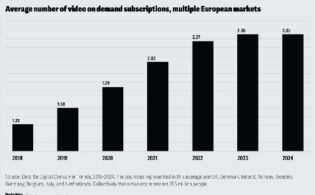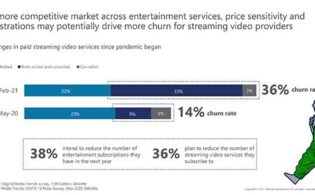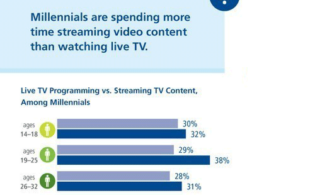In its Technology, Media & Telecommunications (TMT) 2024 Predictions report, Deloitte expects that the number of SVOD tiers offered by leading U.S. platforms will surge from last year’s average of four options to eight.
“Whether consumers want no ads, the best sports leagues and latest blockbusters or prefer to pay less for ads, last week’s highlights and last year’s TV episodes, streaming services are working to have more options to suit everyone’s budget,” Deloitte says. “There are differences in every market, but the behaviors of U.S. streamers may foreshadow broader trends heading for more distant shores.”
As streamers have shifted from a mindset of subscriber growth to one of profitability, they are mulling over charging more for access to premium content, reintroducing contracts and upping the ad load. “Such changes could force a reshuffling of subscribers into more profitable and enduring relationships with streamers and studios,” Deloitte explains.
The changes underway now reflect the realities that major streamers are now facing: the “tactical assumptions” they made about the SVOD landscape were largely wrong, namely the single-minded focus on subs growth, relying on SVOD-only tiers and excessive content spend. “Subscriber growth was critical, but it likely incentivized lower prices and higher content spending to acquire and retain customers who could cancel at any time,” Deloitte notes. “Escalating content costs, high churn rates, low subscription prices and the lack of ad revenue combined to create losses in the 25 to 30 percent range—the mirror image of pay TV profits of +25-35 percent. Investors gave M&E streaming services less time and money to turn things around. The result of the initial disruption, the pressures of COVID-19 and the strategic decisions made many streaming video services unprofitable.”
Meanwhile, amid the streaming wars, millennials and Gen Z are sending more of their time with UGC and video games. “They still subscribe to streaming video but are more likely to churn when they run out of compelling content. This has driven up costs for streamers whose only lever for retention has been hit shows and desirable back catalogs.”
Deloitte notes: “In the quest for profitability, M&E companies should look to find a way to make TV and film accessible to and affordable for as many people as possible, lest they take their engagement elsewhere.”
The big profits of the pay-TV era are unlikely to return for media companies, “but they can adapt their streaming models to boost profits,” Deloitte says. “They’ve already taken some steps to provide differentiated streaming services based on viewers’ content preferences and budgets. Now they can go further with tiered offerings that could enable more households to be subscribers, with premium content pricing and early access to new releases, and with contracts that could drive greater retention.”
Deloitte indicates that in its U.S. survey, more than 40 percent of respondents would be willing to pay more for premium services that include bundled content, such as live sports or video games, even when ads are included with the subscription. Subscribers are also willing to trade small decreases in the subscription price for higher ad loads per hour.
Platforms could charge customers more for access to new movies and series. Deloitte also expects some to reintroduce contracts to make it harder for customers to cancel services. “They may offer bundles that combine multiple SVOD services or other streaming media services at a lower overall price–and with a six-month or year-long subscription. Some may pursue more collaborations with telecoms providing mobile and data plans. This could initially scare off some subscribers, such as those that churn frequently to chase content. But lower-priced tiers and bundles that spread costs out could make it easier for more people to maintain subscriptions–and for streamers to sustain revenues.”
Deloitte goes on to note that 2024 will likely see a “return of some of the mechanisms and business models that helped media and entertainment companies become highly profitable before the streaming revolution. In this way, the industry is expected to try to rewrite the new rules of the game to be more favorable to their businesses.”
The report continues: “More studios and streamers will likely consolidate or rebundle into offerings that make it easier for consumers to find and pay for access to all the content they’re looking for. Others will likely license more of their content to other channels–or fall back from DTC and become content dealers, solely producing content to sell into any channel willing to pay. Some content may include premium pricing, and more are expected to syndicate into other providers, retreating from the cost burdens of exclusive content.”
Jana Arbanas, vice chair at Deloitte LLP and U.S. telecom, media and entertainment sector leader, noted: “In 2024, media and entertainment companies will focus on bringing consumers more of what they want. As streaming services work toward profitability, they’re getting resourceful with how they offer content to viewers. Gaming platforms are giving users the tools to create their own games, which could lead to a boom in quality content but could be a threat to their own business longer term. And fans of top franchises will see their favorite characters and stories in both games and movies. It’s a crucial time as the industry finds new and profitable ways to keep audiences engaged.”





